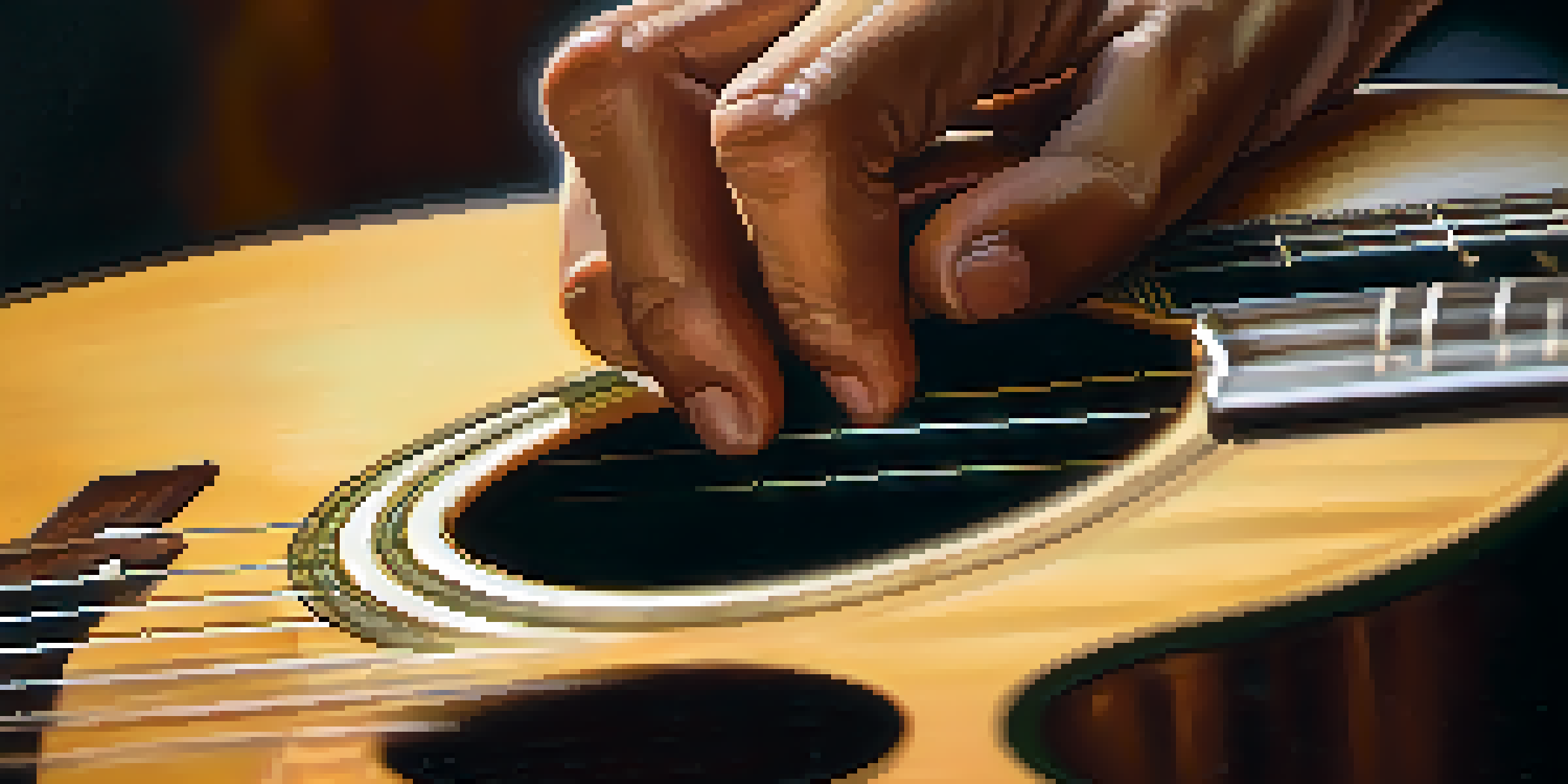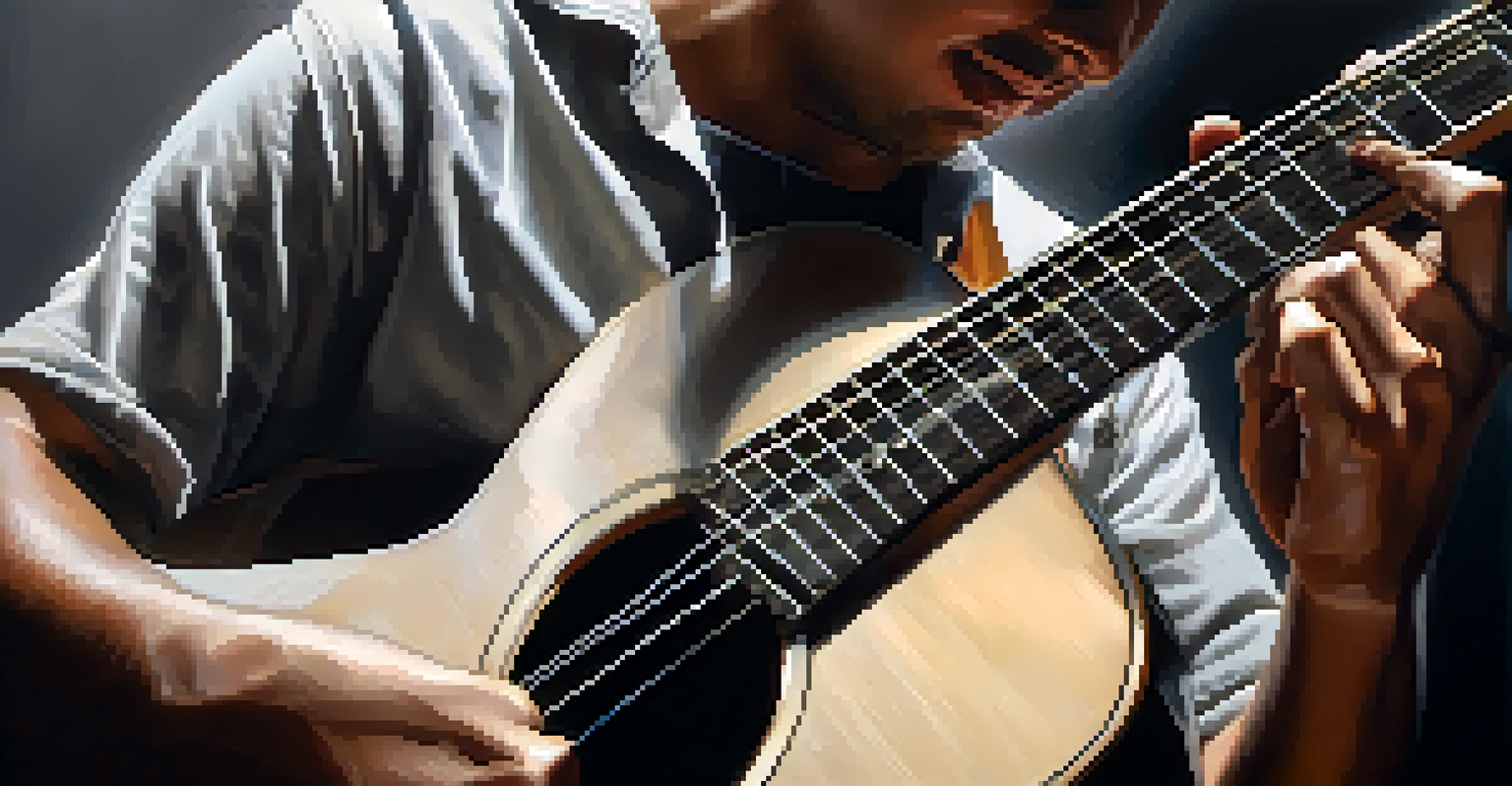Using Fingerstyle Techniques for Unique Rhythm Guitar Sounds

What is Fingerstyle Guitar and Why Use It?
Fingerstyle guitar is a technique where you pluck the strings directly with your fingers instead of using a pick. This method allows for greater control and a more nuanced sound, making it perfect for creating unique rhythms. For many musicians, it opens up a world of possibilities, blending melody and harmony seamlessly.
The guitar is a miniature orchestra in itself.
When you use fingerstyle techniques, you can generate multiple layers of sound simultaneously. Imagine strumming a chord while also playing a melody line; it’s like having a mini orchestra at your fingertips! This complexity can captivate listeners and add depth to your music.
Moreover, fingerstyle can be applied across various genres, from folk to jazz to rock. By mastering this technique, you can enhance your versatility as a guitarist and explore new musical avenues.
Basic Fingerstyle Techniques to Get Started
Before diving into complex rhythms, it’s essential to familiarize yourself with basic fingerstyle techniques. Start by using your thumb for the bass notes and your index, middle, and ring fingers for the higher strings. This foundational approach will help you develop a solid fingerstyle technique.

One simple exercise is to practice alternating bass lines with your thumb while playing a melody with your other fingers. This not only builds coordination but also creates a rich sound that is characteristic of fingerstyle playing. Think of it as juggling; the more you practice, the better you’ll get!
Fingerstyle Offers Unique Sound
Using fingerstyle guitar allows musicians to create rich, layered sounds that blend melody and harmony seamlessly.
As you become comfortable, experiment with different finger placements and patterns. This exploration will pave the way for unique rhythmic sounds that set your playing apart from others.
Creating Unique Rhythmic Patterns with Fingerstyle
One of the most exciting aspects of fingerstyle guitar is the ability to create unique rhythmic patterns. By varying your plucking techniques—like incorporating taps or harmonics—you can add distinct textures to your music. Imagine the difference between a straightforward strum and a rich, syncopated fingerstyle pattern.
Music is the shorthand of emotion.
Try playing around with time signatures as well. While most songs stick to 4/4, experimenting with 3/4 or 5/4 can lead to surprising and engaging rhythms. This is where creativity shines, allowing you to break free from conventional strumming.
Additionally, layering different patterns can result in a captivating soundscape. For example, you might play a steady bass line while interspersing syncopated melodies on top, creating a rhythmic dialogue that keeps listeners engaged.
Using Thumb and Finger Independence for Rhythm
Mastering thumb and finger independence is crucial for creating dynamic fingerstyle rhythms. Your thumb generally handles the bass notes, while your fingers play the melody and chords. This separation allows for greater complexity and variation in your playing.
A great exercise to enhance this independence is to practice simple bass lines while simultaneously playing different melodies. This could be as simple as alternating between two notes with your thumb while playing a chord progression with your fingers. Over time, you'll notice an improvement in your coordination.
Mastering Techniques Enhances Skills
Practicing basic fingerstyle techniques, such as thumb and finger independence, is essential for developing coordination and dynamic rhythms.
By developing this skill, you’ll be able to add more intricate rhythms to your playing, making your performances more engaging and expressive. Think of it as a conversation where each part has its voice; together, they create a beautiful harmony.
Incorporating Percussive Techniques in Fingerstyle
Adding percussive techniques to your fingerstyle playing can elevate your rhythm guitar sound to new heights. Techniques like tapping, slapping, or even using the body of the guitar as a drum can create a lively and engaging performance. It's like turning your guitar into a percussion instrument!
Start by incorporating simple taps on the guitar body in between your plucking patterns. This can add a rhythmic pulse that enhances the overall groove of your piece. Imagine a drummer keeping time while you play; the added rhythm can really bring your music to life.
As you grow more comfortable with these percussive elements, feel free to get creative! Experiment with different sounds and placements on your guitar, transforming your instrument into a versatile tool for rhythm and melody.
Exploring Different Musical Genres with Fingerstyle
Fingerstyle techniques are incredibly versatile and can be adapted to various musical genres. Whether you’re playing folk, blues, jazz, or rock, the fingerstyle approach can bring a fresh perspective to your favorite songs. For instance, using fingerstyle in a classic rock song can infuse a new energy into the familiar tune.
Consider exploring songs from different genres to see how fingerstyle transforms their rhythm and feel. You might find that a blues riff sounds richer when played fingerstyle, or that a folk melody gains depth with the addition of bass lines. This exploration can be both fun and rewarding!
Versatile Across Musical Genres
Fingerstyle techniques can be applied to various musical styles, enriching songs and expanding a guitarist's creative possibilities.
As you delve into different styles, you’ll not only enhance your fingerstyle technique but also develop a broader musical palette. This journey through genres can inspire your own compositions and improve your overall musicianship.
Tips for Practicing Fingerstyle Techniques Effectively
Effective practice is key to mastering fingerstyle techniques. Start slow, focusing on accuracy rather than speed; this will help you build a strong foundation. Think of it like learning to ride a bike; you wouldn’t rush it, right? Gradual progress leads to lasting skills.
Incorporate short practice sessions into your routine, focusing on specific techniques or patterns. For instance, dedicate a few minutes to practicing thumb independence or percussive elements each day. Consistency is more important than marathon sessions; even 10-15 minutes daily can lead to significant improvement over time.

Lastly, don’t forget to record yourself! Listening back can provide valuable insights into your playing and highlight areas that need attention. This reflective practice will not only enhance your fingerstyle skills but also boost your confidence as a guitarist.